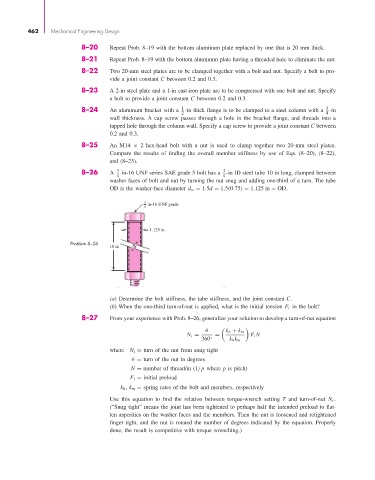Page 487 - Shigley's Mechanical Engineering Design
P. 487
bud29281_ch08_409-474.qxd 12/16/2009 7:11 pm Page 462 pinnacle 203:MHDQ196:bud29281:0073529281:bud29281_pagefiles:
462 Mechanical Engineering Design
8–20 Repeat Prob. 8–19 with the bottom aluminum plate replaced by one that is 20 mm thick.
8–21 Repeat Prob. 8–19 with the bottom aluminum plate having a threaded hole to eliminate the nut.
8–22 Two 20-mm steel plates are to be clamped together with a bolt and nut. Specify a bolt to pro-
vide a joint constant C between 0.2 and 0.3.
8–23 A 2-in steel plate and a 1-in cast-iron plate are to be compressed with one bolt and nut. Specify
a bolt to provide a joint constant C between 0.2 and 0.3.
3
1
8–24 An aluminum bracket with a -in thick flange is to be clamped to a steel column with a -in
2
4
wall thickness. A cap screw passes through a hole in the bracket flange, and threads into a
tapped hole through the column wall. Specify a cap screw to provide a joint constant C between
0.2 and 0.3.
8–25 An M14 × 2 hex-head bolt with a nut is used to clamp together two 20-mm steel plates.
Compare the results of finding the overall member stiffness by use of Eqs. (8–20), (8–22),
and (8–23).
3
8–26 A 3 4 in-16 UNF series SAE grade 5 bolt has a -in ID steel tube 10 in long, clamped between
4
washer faces of bolt and nut by turning the nut snug and adding one-third of a turn. The tube
OD is the washer-face diameter d w = 1.5d = 1.5(0.75) = 1.125 in = OD.
3 in-16 UNF grade
4
1.125 in
Problem 8–26
10 in
(a) Determine the bolt stiffness, the tube stiffness, and the joint constant C.
(b) When the one-third turn-of-nut is applied, what is the initial tension F i in the bolt?
8–27 From your experience with Prob. 8–26, generalize your solution to develop a turn-of-nut equation
θ k b + k m
N t = = F i N
360 ◦ k b k m
where N t = turn of the nut from snug tight
θ = turn of the nut in degrees
N = number of thread/in (1/p where p is pitch)
F i = initial preload
k b , k m = spring rates of the bolt and members, respectively
Use this equation to find the relation between torque-wrench setting T and turn-of-nut N t .
(“Snug tight” means the joint has been tightened to perhaps half the intended preload to flat-
ten asperities on the washer faces and the members. Then the nut is loosened and retightened
finger tight, and the nut is rotated the number of degrees indicated by the equation. Properly
done, the result is competitive with torque wrenching.)

